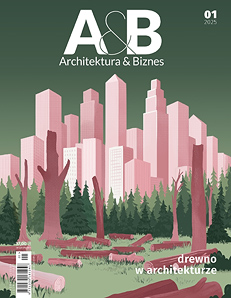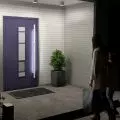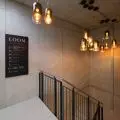Healthy zip code
Can existing buildings be healthy? What should be the goal of an architect's work and what can be learned from seven-year-olds, as well as the fact that the zip code has a greater impact on our health than the genetic code is discussed by Marta Prominska, author of "Healthy Urban Planning. A new standard for urban planning".
Marta PROMIÑSKA - Ph. Director of Sustainability at Strabag, Plenipotentiary of the SARP General Board for Environment and Climate Protection. Architect, urban planner, LEED O+M certified appraiser. A graduate of the Cracow University of Technology. In 2020, she received her PhD from the Silesian University of Technology. Author of many scientific publications, including books: "Healthy Urbanism. A new standard for urban planning" and "Healthy architecture. A new standard for sustainable design." She serves as an advisor to the WELL City 2022-2024 Advisory, and is a member of the Polish Green Building Association.
Dominika Drozdowska: Are Polish cities healthy?
Marta Prominska: There is a word in German - jein - that combines ja and nein, or "yes" and "no." And so it is with Polish cities, which are both healthy and sick. Until relatively recently, due to central planning, Polish urban planning was pro-health. Planning conditions conducive to such goals were created and taken care of. Aeration corridors were created.
Now the law of money tends to rule - which, of course, should not be considered only in negative terms. However, rulers and city officials should be reminded to care for and maintain the quality of urban greenery and spatial layouts, since, as scientific studies indicate, it is the layout of buildings that has the greatest impact on air quality. The best tool for controlling our health, then, are proper local plans. It should also be said that many Polish cities have the potential to be healthy - both smaller towns, uncontaminated by pollution, and large cities that have a conscious pro-climate and pro-health policy.
Dominika Drozdowska: What lies in the area of this "nein"? What diseases plague Polish cities?
Marta Prominska:One of the biggest problems is air quality. A medium-sized city dies annually because of it. Another challenge is urban heat islands. In the 1980s, the number of days per year that were dangerous for people over sixty-five (so-called heat waves) was zero, while in 2021 there were more than seventy! This type of climate change is dangerous and threatens our health and lives. In order to counteract this phenomenon, it is therefore necessary to lower the temperature of the city. In Los Angeles or New York, streets and roofs are painted white. In France, newly designed buildings must have green roofs. For such measures to make sense, they should be carried out on a large scale and supported in legislation. It is also worth mentioning that not all greenery will be suitable. So shade should be managed in an appropriate way.
illustrations from Marta Prominska's book "Healthy Urbanism. A new standard for urban planning," PWN Science Publishing House, Warsaw 2023
© Wydawnictwo Naukowe PWN
Dominika Drozdowska: What kind of shade should be good?
Marta Prominska: We are talking about long-term planning, in which the diameter and density of a tree's crown is calculated on a ten-year basis. This allows you to check whether the shade will actually be effective. To this you also have to add the nuances of the human psyche, which in general is not fond of either too much shade or glare. Urban planning and architecture must keep in mind the complexity of these aspects and the diversity of the population and its needs.
Dominika Drozdowska: Which plant or tree species have you found suitable in your research?
Marta Prominska: I haven't done such research yet, but it is one of my areas of interest. I have, however, checked plants for their impact on the occurrence of allergies - not every planting will be suitable. A list of the right ones was included in the book "Healthy Urbanism. A new standard for urban planning".
Dominika Drozdowska: What else remains in your circle of interest?
Marta Prominska: An absolutely fascinating topic lately is healthy existing buildings. Because it is mainly existing buildings that harm our health. And we are talking not only about historical buildings, but also about buildings that are a decade old and those made of big plates, which should have "died" long ago. I plan to write about the death, diagnosis and diseases of buildings. One area of interest is school buildings, where we stay for a really large part of our lives. In Western Europe, school buildings were among the first to be taken under the microscope during the post-covid period, as a strong need was to bring classes back to stationary form - measures began to be taken to improve air quality, crowd management, as well as lighting, acoustics and general well-being.
Illustrations from Marta Prominska's book "Healthy Urbanism. A new standard for urban planning," PWN Science Publishing House, Warsaw 2023
© Wydawnictwo Naukowe PWN
Dominika Drozdowska: What are the effects of these activities?
Marta Prominska: First of all, the change can be sensed in the amount of air supplied, the choice of filters, and in managing the path of people in such a way that they can reach their place of residence, for example, in a non-contact manner and avoid contact with bacteria and viruses. Unfortunately, Covid-19 was very quickly forgotten, yet all sorts of virus mutations and pandemics will constantly accompany us. In "Healthy Urbanism," I looked at the vestiges of the pandemic in the context of changes implemented in architectural design and urban planning efforts after the diseases have subsided. History shows that cities such as London, Paris and Prague were rebuilt after pandemics. Probably in our case we are not talking about such drastic measures, but we should stop and reflect in a design context.
Dominika Drozdowska: What else can be done to create responsible and healthy spaces?
Marta Prominska: It is very important to design new buildings in such a way that their later adaptation is possible. In existing buildings, structural, architectural or installation changes are possible, but if not included in advance, they can be difficult and costly.
Dominika Drozdowska: I come from Poznań, where one can recently observe the wiping off the map of the city of the Malta shopping mall (designed by APA Wojciechowski Architekci, Ewa and Stanislaw Sipinski Architectural Studio), which operated for fourteen years and is now being demolished. The statements of some residents resound with regret at the enormous amount of work, funds and materials that have been wasted, even thrown away. They also say it's a shame about the place itself - connected to the lake (by a footbridge and a view), with bright, spacious interiors.
Marta Prominska: The fact that residents become attached to a building or space speaks wonderfully of the architects and their work. And this should also be the goal of architectural pursuits. If we had designed from the beginning with adaptive changes in mind, the controversial demolition might not have happened again. However, this requires additional costs, if only in terms of fire safety, the number of entrances to the building or staircases. In New York, many people did not return to their offices after the pandemic, so we are seeing an increased wave of conversion of offices into apartments. In the United States, there has even been a legal push to allow the creation of windowless bedrooms, which would allow offices to be developed. This also shows how, globally, office buildings are under-suited to the possibility of change. In addition, it should be noted that an existing building - unlike a new one - also already has an identity or reputation, which is important to residents. This is an opportunity that can be seized by giving such spaces back to educational, cultural, serving and being closer to the residents, among other purposes.
illustrations from Marta Prominska's book "Healthy Urbanism. A new standard for urban planning," PWN Science Publishing House, Warsaw 2023
© Wydawnictwo Naukowe PWN
Dominika Drozdowska: Can we already talk about examples of buildings whose function has been adapted in a way worth following?
Marta Prominska: I think we are at the beginning of the road. European policy is changing, which will promote and finance green and sustainable architectural solutions even more intensively. So there will certainly be more renovations. There are also fewer and fewer plots of land in the cities, so we will focus mainly on the existing tissue.
Dominika Drozdowska: What solutions could architects introduce during renovation activities?
Marta Prominska: One example is the closed-loop economy. This is the way to design and build in Scandinavia. Next-circuit materials are used, with a high content of recycled materials and even whole construction elements. There are also warehouses where one can buy previously researched second-hand building materials. And in Prague, an old commercial building was adapted - materials from the former one were built into the new office function. These are the activities we should be striving for.
Dominika Drozdowska: Is it due to business or legislation that the closed-loop economy is working in Scandinavia?
Marta Prominska: Although it is the private sector, the State supports such businesses and projects through subsidies or tax breaks. Also in our market, manufacturers of building materials and products, such as concrete, aluminum elements or furniture, are beginning to implement entire lines of low-carbon products. Interestingly, such items, contrary to popular belief, are not much more expensive at all; rather, we are talking about a few percent. The change starts with the big players who have the resources, but more manufacturers will follow. These are initiatives I am very much rooting for and look forward to more.
Dominika Drozdowska: What about interiors? How can architects take care of the health of buildings - the users and the environment?
Marta Prominska:Healthy urbanism is space with healthy parameters. So one should design from a holistic perspective. Starting with legislation (as in California, where health is put first in all procedures), urban intake, lowering the temperature through the right choice of materials or lighting, which affects our endocrine system, among other things. The feeling of well-being in a building is influenced both by the air we breathe and the color of the walls affecting the human psyche. Mental state is also affected by the layout and proportions of the rooms, for example, elongated, narrow and dark interiors will induce fear, anxiety or aggression. Introducing greenery into interiors, the so-called biophilia, will not only work on our psyche, but also on environmental aspects - purifying the air, lowering the temperature, improving the humidity in the room. Too much greenery, through our primal instincts, can also be disturbing - causing fear of spiders, insects, insects. Architecture can harm and poison us, but it can also heal and soothe us. As I wrote in "Healthy Urbanism," scientific studies have shown that the zip code has a greater impact on our health than the genetic code. So this is a topic we need to address.
illustrations from Marta Prominska's book "Healthy Urbanism. A new standard for urban planning," PWN Scientific Publishers, Warsaw 2023
© Wydawnictwo Naukowe PWN
Dominika Drozdowska: In an ideal world, we could get a list of specific materials and solutions.
Marta Prominska: Such lists already exist, if only in the form of multi-criteria systems like LEED, BREEAM, WELL, or the EU Taxonomy, which is a regulation that supports investments in sustainable environmental and climate action. Other regulations include REACH, which regulates the use of chemicals in building materials, among other things.
Dominika Drozdowska: Does multi-criteria certification really work? Do participants in the construction process primarily want to tick off what the certification obligates them to do, or do they do something more?
Marta Prominska: Of course, each party would just like to tick off the points on the checklist [laughs]. Fortunately, multi-criteria certifications consist of mandatory and additional points, and already with the fulfillment of the basic ones we can ensure that the building is somehow healthier. But of course, the higher the overall score, the higher the building will have a higher level of certification, which translates into prestige and the price of rental space.
Dominika Drozdowska: Over the years, green certificates have certainly had an impact on changing attitudes, thinking and the market itself. Do you encounter investors who do more than the right thing?
Marta Prominska: Yes, of course. The loudest applause is due to developers who undertake measures such as BREEAM Communities certifications, which include a broad social aspect. These are not issues that can be converted directly into the price of an investment. It's a huge effort that I have great admiration for; an added value that ultimately pays off, however, and such developers stand out significantly in the real estate market.
Dominika Drozdowska: What kind of activities does BREEAM Communities require?
Marta Prominska: These are all sorts of solutions - from creating spaces that serve the local community and meet its requirements, but also asking representatives of the local community about their needs and meeting them. Workshops and consultations are held at various stages of the project, and even if an idea cannot be implemented, its rejection must be justified. Before the project starts, discussions are held with local residents. It is great not only to ask questions, but most importantly to implement the ideas of residents. The result is a unique project that has a chance to exist. We are also talking about a reflection for the developer and architect inspiring the next steps. I recall one such realization, in which a simple, educational action was taken - and tree species were described in a clear way.
Dominika Drozdowska: What is the post-construction feedback for such investments, primarily from local communities?
Marta Prominska: Some time ago I participated in the LEED for Operations and Maintenance certification, which is the evaluation of an existing building. For me as an architect, the biggest lesson was to gather user feedback. I would never have thought that they could perceive architecture in such different ways. For example, some people were afraid of the representative staircase. They felt anxiety about what would happen in the event of a fire, as they indicated that such an escape route would be dangerous. This was due to insufficient knowledge that the building located staircases with appropriate parameters for evacuation. After being instructed on how the building works, these people changed their skeptical attitude toward the facility. Other users made comments about the glass balustrade, which compounded their fear of heights. In this case, it's a lesson for future designers and investors indicating that it's worth rethinking solutions that are spectacular or beautiful in terms of the potential fears of future users of the space.
Dominika Drozdowska: I'm curious if publishing books on architecture and urban planning is related to your work at Strabag, or if it's an academic job.
Marta Prominska: Writing on these topics is my passion. It started with my PhD, which I started just before the Covid-19 pandemic, and defended in a rather fast pace of two years. After that, I couldn't stop [laughs]. And now I feel that I have even more to say in connection with my position at Strabag. I also read a lot of publications, and the more I know, the more I would like to say, especially in areas that seem still undeveloped. My idol is Jane Jacobs, who was neither an architect nor a real-life scientist, but has made enormous contributions to the field of urban planning and its social side. I'm also looking at what Joseph Allen, a professor at the Harvard T.H. School of Public Health, who studies healthy buildings, has even created his own rating system determined by health aspects.
Dominika Drozdowska: What kind of response is the book "Healthy Urbanism" getting? Who is reading it?
Marta Prominska: I am very pleased that "Green Urbanism" is read by architects and officials, as well as representatives of other industries, including ventilation or electrical, without which healthy architecture cannot exist. I know that community activists and those involved in politics are also reaching for it. And also readers unrelated to the industry, which is great, because the topic of health affects all of us.
Marta Prominska, author of the book "Healthy Urban Planning. A new standard for urban planning"
Photo: Mateusz Zelnik,© Wydawnictwo Naukowe PWN
Dominika Drozdowska: It turns out that we all need healthy urban planning.
Marta Prominska: Yes, we are responsible for the entire urban ecosystem and its inhabitants. That's why I think a lot of potential lies in the management of cities and in the resolutions of city councils, which can realistically introduce pro-healthy urbanism. It's important to have the widest possible conversation.
Dominika Drozdowska: This sounds like a fascinating challenge for everyone who creates a city. And also for students and future architects.
Marta Prominska: Yes, brand new schools of architecture are already emerging that take into account sustainable, pro-climate and circular design, which treats local and global aspects equally. The science of architecture and urban planning is beginning to go beyond their classical framework, and is betting on interprofessional diversity.
Dominika Drozdowska: In conclusion: what is your prescription for a healthy city?
Marta Prominska: I will refer to the first sentence of my book. It's a quote from my son, whom I asked what a healthy city is, and his answer touched me, because it was so clear and multidimensional that I wrote it down without any corrections. I begin my first book with the words of Winston Churchill, about how we shape buildings and then they shape us. I begin the second with the words of a seven-year-old child: "A healthy city is one where everything rolls into the future." Let's ask our children for their opinions. Their thoughts are simple and untainted by worldviews, habits, prejudices or judgments. This primal, childlike thinking is the wisest. It really is.
Dominika Drozdowska: Thank you for the interview.
interviewed by: Dominika Drozdowska
Illustrations provided courtesy of Marta Prominska and PWN Scientific Publishers.




































